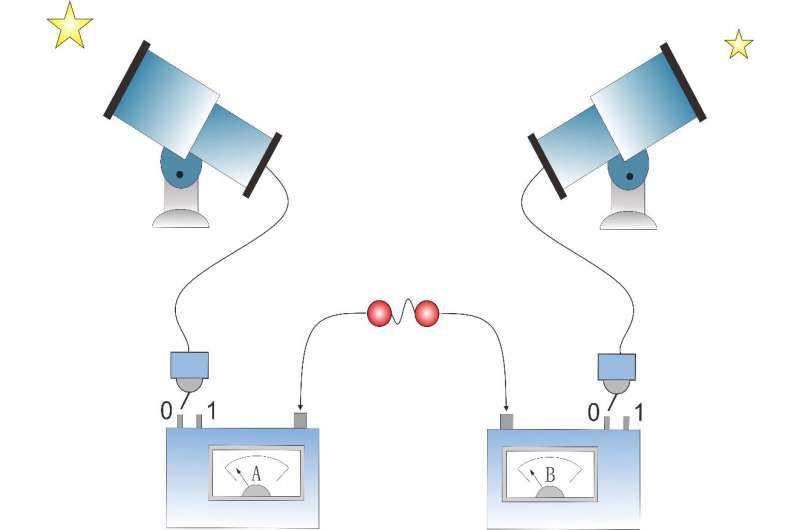Cracking a decades-old test, researchers bolster case for quantum mechanics

In a new study, researchers demonstrate creative tactics to get rid of loopholes that have long confounded tests of quantum mechanics. With their innovative method, the researchers were able to demonstrate quantum interactions between two particles spaced more than 180 meters (590 feet) apart while eliminating the possibility that shared events during the past 11 years affected their interaction.
A paper explaining these results will be presented at the Frontiers in Optics + Laser Science (FIO + LS) conference, held 15–19 September in Washington, D.C., U.S.A.
Quantum phenomena are being explored for applications in computing, encryption, sensing and more, but researchers do not yet fully understand the physics behind them. The new work could help advance quantum applications by improving techniques for probing quantum mechanics.
A test for quantum theories
Physicists have long grappled with different ideas about the forces that govern our world. While theories of quantum mechanics have gradually overtaken classical mechanics, many aspects of quantum mechanics remain mysterious. In the 1960s, physicist John Bell proposed a way to test quantum mechanics known as Bell's inequality.
The idea is that two parties, nicknamed Alice and Bob, make measurements on particles that are located far apart but connected to each other via quantum entanglement.
If the world were indeed governed solely by quantum mechanics, these remote particles would be governed by a nonlocal correlation through quantum interactions, such that measuring the state of one particle affects the state of the other. However, some alternate theories suggest that the particles only appear to affect each other, but that in reality they are connected by other hidden variables following classical, rather than quantum, physics.
Researchers have conducted many experiments to test Bell's inequality. However, experiments can't always be perfect, and there are known loopholes that could cause misleading results. While most experiments have strongly supported the conclusion that quantum interactions exist, these loopholes still leave a remote possibility that researchers could be inadvertently affecting hidden variables, thus leaving room for doubt.
Closing loopholes
In the new study, Li and his colleagues demonstrate ways to close those loopholes and add to the evidence that quantum mechanics governs the interactions between the two particles.
"We realized a loophole-free Bell test with the measurement settings determined by remote cosmic photons. Thus we verified the completeness of quantum mechanics with high-confidence probability," said Ming-Han Li of the University of Science and Technology of China, who is lead author on the paper.
Their experimental setup includes three main components: a device that periodically sends out pairs of entangled photons and two stations that measure the photons. These stations are Alice and Bob, in the parlance of Bell's inequality. The first measurement station is 93 meters (305 feet) from the photon pair source and the second station is 90 meters (295 feet) away in the opposite direction.
The entangled photons travel through single mode optical fiber to the measurement stations, where their polarization state is measured with a Pockels cell and the photons are detected by superconducting nanowire single-photon detectors.
In designing their experiment, the researchers sought to overcome three key problems: the idea that loss and noise make detection unreliable (the detection loophole), the idea that any communication that affects Alice's and Bob's measurement choices makes the measurement cheatable (the locality loophole), and the idea that a measurement-setting choice that is not "truly free and random" makes the result able to be controlled by a hidden cause in the common past (the freedom-of-choice loophole).
To address the first problem, Li and his colleagues demonstrated that their setup achieved a sufficiently low level of loss and noise by comparing measurements made at the start and end of the photon's journey. To address the second, they built the experimental setup with space-like separation between the events of measurement setting choice. To address the third, they based their measurement-setting choices on cosmic photon behavior from 11 years earlier, which offers high confidence that nothing in the particles' shared past—for at least the past 11 years—created a hidden variable affecting the outcome.
Combining theoretically calculated predictions with experimental results, the researchers were able to demonstrate quantum interactions between the entangled photon pairs with a high degree of confidence and fidelity. Their experiment thus provides robust evidence that quantum effects, rather than hidden variables, are behind the particles' behavior.
More information: "Test of Local Realism into the Past without Detection and Locality Loopholes" by Ming-Han Li, et al., will be presented Monday, 16 September 2019, at 11:15 a.m. EDT in room Washington 4 of the Marriott Wardman Park hotel in Washington, D.C.
Provided by The Optical Society



















